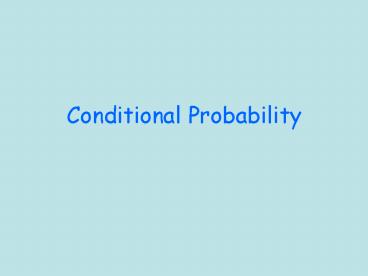Conditional Probability - PowerPoint PPT Presentation
Title:
Conditional Probability
Description:
... was a diamond the first card is a diamond and the second card is a spade draw a tree diagram illustrating this Find the probability that a chip is ... – PowerPoint PPT presentation
Number of Views:38
Avg rating:3.0/5.0
Title: Conditional Probability
1
Conditional Probability
2
Objectives
- Find the probability of an event.
- Apply rules of conditional probability.
- Draw a tree diagram to determine a conditional
probability.
3
Vocabulary
- conditional probability
4
Formulas
5
Tree Diagram Summary
- Conditional probabilities start at their
condition. - Nonconditional probabilities start at the
beginning of the tree. - Multiply when moving horizontally across a limb.
- Add when moving vertically from limb to limb.
6
In a newspaper poll concerning violence on
television, 600 people were asked, "What is your
opinion of the amount of violence on prime-time
television -- is there too much violence on
television?". Their responses are summarized in
the table below.
Yes No Dont Know Total
Men 162 95 23 280
Women 256 45 19 320
Total 418 140 42 600
7
Yes No Dont Know Total
Men 162 95 23 280
Women 256 45 19 320
Total 418 140 42 600
- p(yes)
- p(men)
- p(yes men)
- p(men yes)
- p(yes ? men)
- p(men ? yes)
8
Standard Deck of Cards
9
Cards are dealt from a full deck of 52. Find the
probability of each of the given events.
- the first card is a diamond
- the second card is a spade, given that the first
card was a diamond - the first card is a diamond and the second card
is a spade - draw a tree diagram illustrating this
10
A personal computer manufacturer buys 38 of its
chips from Japan and the rest from America. 1.7
of the Japanese chips are defective, and 1.1 of
the American chips are defective.
- Find the probability that a chip is defective and
made in Japan. - Find the probability that a chip is defective and
made in America. - Find the probability that a chip is defective.
- Find the probability that a chip is defect-free.































